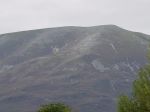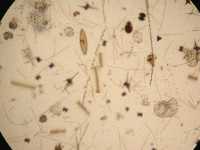
|
 |
|
Last Updated: 2, Apr 2018 - 10:02 |
Yawn, yawn, silicon - very common - element number 14 - seventh most abundant element in the universe - second most plentiful element in the Earth's crust - sand and glass are largely composed of silicon. So that's the science bit out of the way.

Nephin is largely composed of silicon
|
Now what's all this about silicone breast implants? People deformed and dying due to implants? Silicone as opposed to silicon is a rubbery polymer of silicon, which is supposed to be largely inert. Apparently most of the problems arise due to reoperations or complications when implants are replaced or repaired. This is considerable as over 20% of patients may need some intervention over the seven to eight year period following the initial implants. There are plenty of websites out there illustrating the gruesome results that can occur. The older technique of direct injection of silicone into women's breasts seems to have been a particularly big mistake. There have been huge class action suits and multi-million awards to women suffering from implants that have gone seriously wrong. As for cancers and other diseases, the official assessment of the evidence suggests that those with implants are no more likely to contract cancer than the general population. The lack of long term research and epidemiology is worrying, however. The US FDA has a website detailing the risksand the current status of silicone implants. Generally they are now only available for reconstructive surgery following mastectomies and similar serious medical conditions. Silicone is also used in lots of other prosthetic devices from joints to heart valves.
The other big use of silicon (apart from its ever-presence in the ground beneath our feet) is in chips. Where would we be today without silicon chips? The invention of the transistor started modern electronics off, replacing huge vacuum tubes with a relatively small chip of silicon that could do the same job of controlling and amplifying electric currents. It was clear from the minute that the first transistor worked in 1947 that it was a revolutionary moment. But the inventors could not have foreseen that millions of transistors, resistors, diodes and capacitors could be scrunched into such tiny spaces as in modern microprocessors. Popular Mechanics in 1949 stated that it may be possible to build computers that will weight less than 1.5 tons. Circuits are so small nowadays that the 'wires' carrying electrons are not much thicker than the diameter of individual atoms.
Silicon runs our lives today. The traffic lights at the end of Linenhall Street, the brakes in your car, your TV and radio your fridge and dishwasher, mobile phone and, of course, computers, weapons, smart bombs, ICBM missiles, nuclear power stations and so on! All based on the now ubiquitous microprocessor built on a silicon base. I still have a New Scientist magazine from the early 1970s with an article declaring definitively that it would never be possible to programme microprocessors in high level languages. Only an elite few would be able to handle the long binary and numeric coding necessary to make them do sensible things. Little did they know! A touch of the "640k ought to be enough for anybody" (Bill Gates 1981) or "There is no reason why anyone would want a computer in their home" Ken Olsen Founder of Dec Computers in 1977.
Another silicon snippet from one of the really great scientists - Darwin. Reading the Voyage of the Beagle you get an idea of his wide range of his interests. For example, on a beach in South America he spent time unearthing a 'fulgurite'. This is when the silica in the sand is fused into pure glass by a bolt of lightning heating it to 30K°C for a second or two. He followed the shape of the lightning bolt zig-zagging down into the sand literally digging it out.

Diatoms - the tiny plants floating around in our lakes and oceans make their outside shells from silica
|
Finally an interesting thing from sci fi novels and episodes of star trek. There are some very striking similarities between the chemistry of silicon and carbon - such that it is possible to envisage that life itself could be based on silicon rather than carbon. No doubt Darwin would have found that an interesting branch of evolution. The suggestion has even been made that silicon-based bacteria may be found in the Earth's crust at high temperatures and pressure. Of course there is one very common life-form in our oceans and lakes which uses silicon to form tiny protective shells - these are the planktonic algae called diatoms the photograph is from the Irish EPA water quality web siteshowing diatoms among the phytoplankton from Lough Beltra.
Next Up: Phosphorus
Previous Element: Amazing Aluminium - Unlucky 13
|
© Copyright 2002 by © Contributor(s) and Castlebar Web Pages 1997 - 2018
..
Top of Page
|
|
 |

|